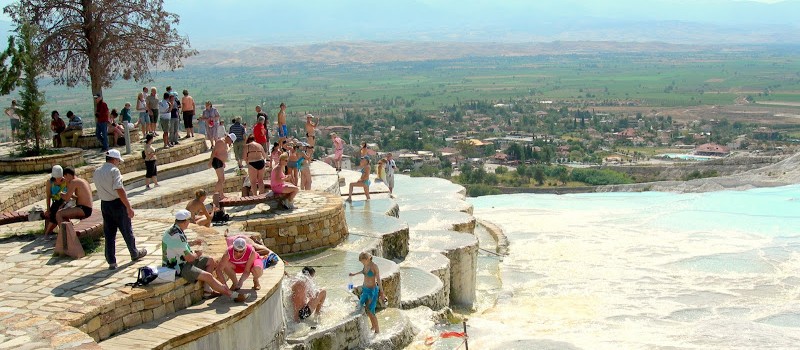Visiting Pammukale- The UNESCO World Heritage site
After spending some time at the holy place and experiencing its mystical beauty,we headed back to Kusadasi. Scheduled next was a day long tour to the region of Hierapolis and the cotton terraces of Pamukkale – one of the most spectacular places in Turkey. As you drive for about 3 hours around the Aegean coast from Kusadasi, you turn inland towards Denizli to reach the UNESCO town of HIERAPOLIS-Pamukkale also known as the Cotton Castle. Here, thermal spring waters laden with calcium run off the plateau’s edge, creating a cascade of petrified basins – an extraordinary work of art created by nature.
The ancient city of Hierapolis located around 19 kilometres north of Denizli, is at an altitude of 100 metres above the Meander excavations. During the Hellenistic era, the thermal springs at Hierapolis made it a very popular spa and today the ruins of Hierapolis have many visitors not only for its history but also to swim in its mineral rich pools and see the terraces of Pamukkale.
The ancient city of Hierapolis itself was known as the Holy City in archeological literature because of the abundance of temples and various other religious structures in the area. It derives its name from Heira which means sacred city because of the religious events that took place here.
There is a large cemetery area in this region and therefore it is also known as the Necropolis or the city of the dead. People used to come here to heal in the hot spas which were in existence since the 2nd Century BC and many of them retired and died here. The great baths were constructed with huge stone blocks without the use of plaster, and consisted of various closed or open sections linked together. There are deep niches in the inner section of the bath, library, gymnasium and other closed or open locations. The complex constitutes a good example of vault-type architecture. The complex is now an Archaeological Museum.
After the formation of the large white limestone, the hot springs became famous in the 20th century as the tourist attraction, known as Pamukkale.
The city of Hierapolis along with Pamukkale was included in the UNESCO World Heritage Sites in 1988. The ancient city was rediscovered, but also partially destroyed by hotels that were built there. These buildings were removed again in recent years. The hot water pool of one hotel was retained, and, for a fee, it is possible to swim amongst ancient stone remains.
Pamukkale is one of Turkey’s most popular and photographed sights. Terraces are formed when the water from the hot springs loses it carbon dioxide as it flows down the slopes, which in turn leaves deposits of limestone, creating layers of white calcium carbonate formation. These formations are built up in steps on the plateau and that is probably how it has earned its name Pamukkale or cotton castle. The ancient city of Hierapolis was built on top of the white “castle” which is about 2700 meters long and 160m high. As you drive uphill into the region, you can see the white terraces from a distance. The region enjoys a temperate climate all year round.
The spring water which fills into these white terraces are at 350oC and forms an extraordinary phenomenon with their travertine deposits of calcium carbonate. The waters here are believed to have been used by Emperors who came here for various treatments such as cardiovascular disorders, blood pressure anomalies, skin eruptions as well as disorders of the digestive system. In fact the Turkish people call Pamukkale the 8th wonder of the world for its amazing beauty and fantastic formations of stalactites and basins. One of the popular stops is a swim at the Cleopatra Pool which is supposed to have strong healing powers as it is littered with fragments of marble columns which are associated with the Temple of Apollo.This is the only place where bathing is allowed as it is forbidden to bathe in the cotton terraces. An overnight stay inPamukkale and Hierapolis is highly recommended to explore the region extensively.
The following day, I flew from Izmir into Istanbul and thereafter to take my connecting flight to Mumbai, after having visited one of the most fascinating countries, which has a unique influence of two continents – Asia and Europe.
For those planning a holiday, Turkey is a dream destination, as you can stay at a cave hotel in Cappadocia, admire the natural beauty of the amazing cotton castle at Pamukkale or experience rich history and cruise along the Bosphorus in Istanbul, the only city in the world which is located in two continents. Namaste Turkey has some very unique itineraries to make your visit to Turkey one of your most memorable holiday experiences.




